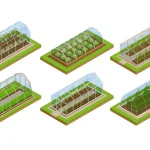
Hydroponic Systems
Hydroponic gardening is a method of growing plants by feeding them through water as opposed to depending of break down of ingredients in soil. There is an array of systems available on the market for consumers to buy and instructions on building your own. From something as simple as a soda bottle plumbed with an aerator to prefab professional reservoir and tray methods, hydroponics systems are only limited by imagination. There are however 6 basic types of hydroponic systems that have been defined simply by the method the water is delivered to the plant: Aeroponic, Nutrient Film Technique, Drip, Ebb and Flow, Deep Water Culture, and Wick. Each type of system has its advantages and disadvantages and will work better for different cultivators based on ease, cost, space, plant requirements, and personal preference. Most of these systems will require a water pump to deliver the nutrient rich water to the plant, however some systems are setup where the plants will wick the water or gravity will feed the plant as they need. Systems with no active pump are called passive systems.
Wick
The most basic system is a Wick system. It is a passive system with no water pump or timer. Plants grow in a fashion allowing the root zone to pull up moisture and nutrients from the reservoir below. As the top surface of the container drys the osmotic pressure pulls the water from the bottom. The most common types of wicks are usually small pieces nylon twine/rope or porous absorbent hydroponic mediums such as perlite, or coconut coir, or other inert medium. This system in its simplicity works great but it isn’t as aggressive growing as other systems, and wicking ability can diminish as salts and organic lock into the wick. Medium should be flushed regularly to remove salts. A minimum on once a month is recommended.
Deep Water Culture (DWC)
Deep Water Culture is similar to wick only instead of water being pulled into the root system the plants roots are submerged in a nutrient rich solution. Plants are again planted in an inert growing medium, and are planted right above the nutrient rich water. The roots grow down from the medium and are always submerged in the water. The most important difference here is that an air pump and air stone (similar to ones put in a fish aquarium) are placed at the bottom of the nutrient reservoir to provide adequate oxygen to the root system. With out adequate oxygen in the root system the roots will harbor anaerobic bacteria, breeding disease (called pythium and weak growth). The rule with this type of system is the larger the plant the more oxygen you will need to add to keep the roots happy.
Ebb and Flow Systems
The simplest system that uses an active water pump is an ebb and flow type system. Plants are planted in a growing medium in a tray above the reservoir and have no contact with water whatsoever. A pump placed in the reservoir and is connected to a timer and when the timer turns the pump on, it floods the entire tray and pots holding the plants. When the timer turns off, the water drains back down into the reservoir siphoning oxygen back into the pots. The pump floods the tray long enough to fully soak the roots and growing medium, but not long enough to drown the roots from lack of oxygen. The tray usually floods several times a day, keeping the roots wet and nutrients always available to your plants. How often and how long you flood will be determined by environmental factors such as temperature, your growing mediums ability to absorb water, and plants watering requirements.
Top Feed Drip
The next system is called a drip system which is similar to an irrigation system in a yard. This system is simple and works well. Plants are planted in the growing medium, and hang over the top of a tray that drains back into the nutrient reservoir (think rain gutter). A drip line is placed at the base of each plant, which is fed by a pump in the reservoir. This system supplies a constant feed of water to the plants, but not enough water to restrict oxygen. The excess nutrient solution drains back into the reservoir where it is pumped back into the system.
Nutrient Film Technique (NFT)
Nutrient Film Technique systems are the 5th type of system. The plant is usually supported in a round net pot that is fitted into the top of a round or square channel of pvc. The nutrient solution is pumped through one end of the channel and the plants roots pick up the nutrients and water as it passes by them, and the water is then dropped back into the reservoir through a return feed on the other end of the channel. A pump is always running, providing a nutrient film that provides enough nutrient solution to the plants, but not enough to submerge the roots. This system saves the expense and labor of replacing growing medium after each crop, but has some large disadvantages. If your pump fails or power goes out, your roots will dry out very quickly and your plants will die.
Aeroponic
The last system is called an aeroponic system. This system is the most high tech and complex system, but also yields the biggest and fastest growth. In this system, plants are placed in a plastic mesh basket filled with growing medium similar to NFT. In this system, the plant’s roots grow from the mesh basket and are constantly misted with nutrient solution. This allows the plant to grow in near perfect growing conditions – the roots are always exposed to oxygen, nutrients, and water. Because the plants are always exposed to everything they need, you will yield the greatest results in the least amount of time. Aeroponics has a few major set backs though. First, it is the hardest to engineer, things can go wrong just a fast as they can go right. Secondly, like the NFT, if the pump fails, you have very little time to keep the plants from totally drying out. Lastly, aeroponics is the most expensive system to make as it requires higher pressure pumps, the most amount of pieces, and is labor intensive. I think of aeroponics system as a turbo charged race car, it will get you where you want to be the fastest way possible, but if you don’t know how to drive it, the results will be dire.
 Growing Accessories
Growing Accessories







